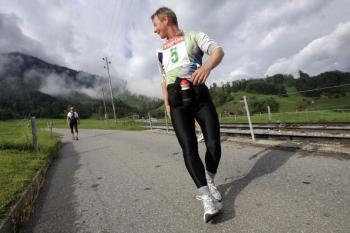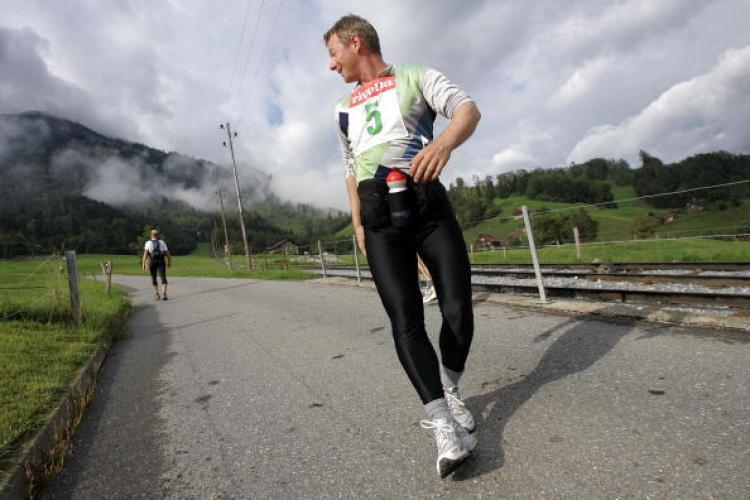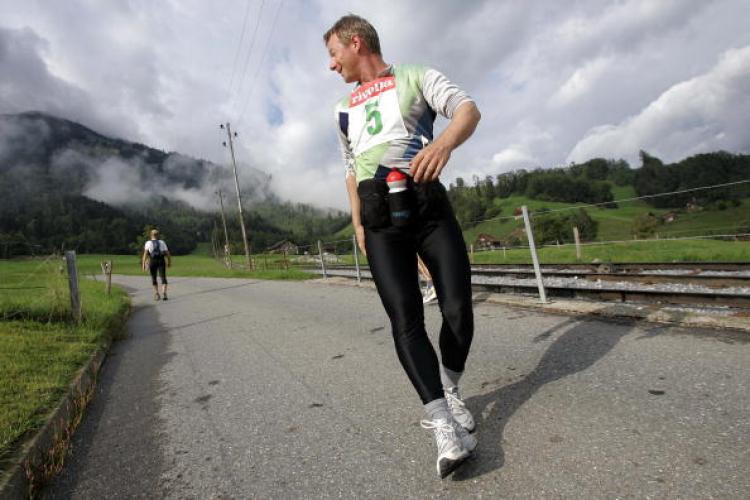Britain’s best backwards runners took to the track in the U.K.’s Backward Running Championships in Heaton Park, Manchester, last weekend—an odd spectacle, but the sport is growing.
Garret Doherty, an Irish reverse runner and previous world backward running world champion, won the day with the best backward mile with a quick 7 minutes 30 seconds.
Running backwards is not just competitive, it is also promoted as a more complete workout than going forward since it works the quads, calves and shin muscles and is easy on the knees.
Backward running has grown in popularity globally, but still doesn’t take itself all that seriously, remaining firmly in the category of Wacky Races. For instance, the New York Road Runners’ annual backwards mile race is held on April Fool’s Day.
James Bamber, organizer of Sunday’s run, and owner of the only U.K. website dedicated to backward running, Reverse Running, has researched and published a book called “Wacky Nation: 50 Unbelievable Days Out at Britain’s Craziest Contests.” These include, World Clog Cobbing Championships, World Pea Throwing Championships, Bottle Kicking, soccer with goals a mile apart, World Hen Racing Championships, World Worm Charming Championships, Shin Kicking, Cheese Rolling, and some of the better know games like the World Nettle Eating Championships or the World Gurning (making distorted facial expressions) Championships.
James organized the Manchester race and also competed (although not very successfully by his own, self-deprecating account).
Competitive backward running is gaining momentum. World records are falling every few years. But the 100-meter record remains elusive. The world record of 13.6 seconds for the 100-meter set by Ferdi Ato Aboboe in 1991 was only been equaled by Roland Wegner, 15 years later in 2007.
The world record for running 100 meters forward is 9.69 seconds, held by Usain Bolt from Jamaica.
While humans run forward “naturally,” backwards running needs to be learned. It’s not just about looking over the shoulder, the entire muscle system used is different. It has its own motor program that requires practice to increase efficiency.
Million-pound footballers use it in training. Champion boxers Mohamed Ali, known for his butterfly footwork, and Gene Tunney did too. Steve Reeves, a famous muscle-builder also did.
Jon Voight, the Hollywood actor, thinks that reverse running helps clear his head.
“As you get older, you have to do something to keep yourself fit,” he says. “You have to watch what you eat and I have a little regimen I do that I don’t tell anybody about.
“A couple times a week I go running and I run backwards. I run up hills.”
Running backwards was reportedly practiced in ancient China before being adopted in Europe in the 19th century.
Garret Doherty, an Irish reverse runner and previous world backward running world champion, won the day with the best backward mile with a quick 7 minutes 30 seconds.
Running backwards is not just competitive, it is also promoted as a more complete workout than going forward since it works the quads, calves and shin muscles and is easy on the knees.
Backward running has grown in popularity globally, but still doesn’t take itself all that seriously, remaining firmly in the category of Wacky Races. For instance, the New York Road Runners’ annual backwards mile race is held on April Fool’s Day.
James Bamber, organizer of Sunday’s run, and owner of the only U.K. website dedicated to backward running, Reverse Running, has researched and published a book called “Wacky Nation: 50 Unbelievable Days Out at Britain’s Craziest Contests.” These include, World Clog Cobbing Championships, World Pea Throwing Championships, Bottle Kicking, soccer with goals a mile apart, World Hen Racing Championships, World Worm Charming Championships, Shin Kicking, Cheese Rolling, and some of the better know games like the World Nettle Eating Championships or the World Gurning (making distorted facial expressions) Championships.
James organized the Manchester race and also competed (although not very successfully by his own, self-deprecating account).
Competitive backward running is gaining momentum. World records are falling every few years. But the 100-meter record remains elusive. The world record of 13.6 seconds for the 100-meter set by Ferdi Ato Aboboe in 1991 was only been equaled by Roland Wegner, 15 years later in 2007.
The world record for running 100 meters forward is 9.69 seconds, held by Usain Bolt from Jamaica.
While humans run forward “naturally,” backwards running needs to be learned. It’s not just about looking over the shoulder, the entire muscle system used is different. It has its own motor program that requires practice to increase efficiency.
Million-pound footballers use it in training. Champion boxers Mohamed Ali, known for his butterfly footwork, and Gene Tunney did too. Steve Reeves, a famous muscle-builder also did.
Jon Voight, the Hollywood actor, thinks that reverse running helps clear his head.
“As you get older, you have to do something to keep yourself fit,” he says. “You have to watch what you eat and I have a little regimen I do that I don’t tell anybody about.
“A couple times a week I go running and I run backwards. I run up hills.”
Running backwards was reportedly practiced in ancient China before being adopted in Europe in the 19th century.






